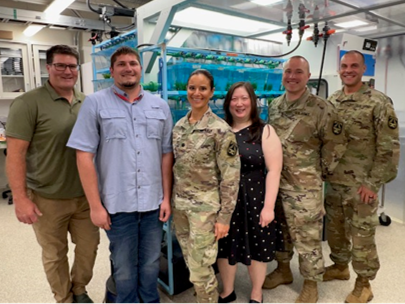WRAIR's Aquatics Lab Helps Identify Potential Sepsis Drug Candidates

Researchers at the U.S. Army Medical Research and Development Command's Walter Reed Army Institute of Research, Experimental Therapeutics Branch, recently succeeded in screening more than 600 drugs in only four months to help identify new medicines capable of preventing sepsis, a life-threatening complication of combat wound infections.
Sepsis occurs when the body's inflammatory response to bacterial infection goes into overdrive and causes cascading organ failures that can lead to death. Studies have shown that untreated infections can progress to sepsis within three days. Sepsis is especially a concern for Warfighters operating in austere environments where prompt medical evacuation is not always readily available.
Because the body's immune response is so complex and difficult to understand, sepsis treatment has traditionally focused on helping the patient ride out the condition by reducing inflammation as it arises in individual organs and treating the bacterial infection with antibiotics. Efforts to develop drugs capable of preventing inflammation and other processes that trigger sepsis have been hindered in part by the slow pace and expense of traditional drug discovery methods.
Mark Widder, a research biologist who manages the Experimental Therapeutics Branch's Aquatic Research Facility, located at Fort Detrick, saw an opportunity to bring the branch's expertise in discovering and developing globally impactful medical countermeasures for military-relevant infectious diseases and operational environment stressors to bear on addressing this unmet need. He received research funding support from MRDC's Military Infectious Disease Research Program to develop larval zebrafish models of endotoxemia to screen a library of 644 drugs already approved by the U.S. Food and Drug Administration for other uses, to determine their ability to treat sepsis. Endotoxemia is a condition caused by toxins released into the bloodstream by bacteria that have been killed by antibiotics. It is a strong indicator that a person has sepsis.
Widder, the project's principal investigator, says that zebrafish were an ideal choice for this project. Because their immune systems and genetic makeup are very similar to ours, their reaction to inflammation-reducing drugs is highly predictive of human responses. They are easy to breed and lay hundreds of eggs at a time, which saves time and money. In their larval form they are transparent, which allows for non-invasive monitoring of tissues and cells. And because they grow quickly – just five days from fertilization to fully functioning larvae – they allow for rapid drug screening.

“It's generally an order of magnitude less costly and time consuming than using a mouse model to conduct a similar study,” says Widder.
“The aquatics research team was focused at the time on using zebrafish for environmental health protection assessments,” explains Lt. Col. Charlotte Lanteri, Ph.D., director of the Experimental Therapeutics Branch, which oversees the Aquatic Research Facility. “We did quite a big pivot to applying the zebrafish models to drug discovery and development.”
The Aquatic Research Facility is uniquely capable of conducting this type of preclinical animal model rapid drug discovery. It is equipped with automated water quality maintenance and monitoring systems and features a special water system that reduces disease prevalence and contamination risk. The staff has the skills and experience to mass produce several different species of fish and to develop new assays on short notice to address changing military missions.
Widder and his team set up a process by which the candidate drugs identified by MIDRP could be quickly screened using batches of larval zebrafish. The screening process determined how effectively each drug compound neutralized the effects of various concentrations of lipopolysaccharide, or LPS – the toxin that causes endotoxemia – in the zebrafish. They found that, of the 644 drugs tested, four were able to prevent the toxic effects of LPS in all the fish tested, while another 29 compounds were able to prevent them in over 60% of the treated fish.
“We have submitted a provisional patent application for our top 16 drugs, which collectively showed better than 80% efficacy, which is pretty amazing,” says Widder, who presented the results of his team's research at the 2023 Military Health System Research Symposium in August and is preparing a manuscript summarizing the findings for submission to a scholarly journal. “We've developed a proposal to test our top compound in a mouse model. We'd also like to engage with the pharmaceutical industry to potentially co-develop some of these drugs, and there are plans to further evaluate the top compounds in the hopes that they'll go into clinical trials.”
“We just finalized the work a couple months ago, so obviously this is all still a work in progress,” Widder adds. “But it is very exciting.”
Lanteri says that the sepsis drug screening project is an excellent demonstration of the ability of the Experimental Therapeutics Branch to bring whole-animal-model rapid screening to bear on accelerating drug discovery that saves military and civilian lives.
“If we had used traditional animal models to test the 644 drugs, it would have taken years,” she says. “The fact that sepsis is such a big challenge for the military and for global public health in general, it's important that we're able to make new discoveries like this. Having this unique capability is a tremendous asset for WRAIR.”














